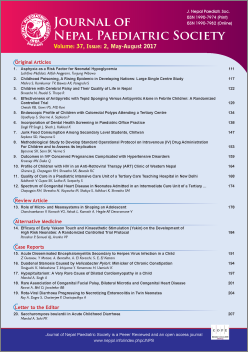Endoscopic Profile of Children with Colorectal Polyps Attending a Tertiary Centre
DOI:
https://doi.org/10.3126/jnps.v37i2.17715Keywords:
Gastrointestinal, Juvenile rectal polypAbstract
Introduction: Polyps are the most common causes of colorectal bleeding in children. This report describes an endoscopic profile of children with colorectal polyps at Nepal Medical College and Teaching Hospital.
Materials and Methods: This prospective study was conducted in children who were evaluated for painless lower GI bleed who underwent colonoscopyin Nepal Medical College, Kathmandu, Nepal from November 2014 to May 2017. Patients with age of presentation less than or equal to 18 years and diagnosed endoscopically to have colorectal polyp were included in the study and were followed up till histopathological reports.
Results:A total of 35children with colorectal polyps were identified. Twenty-three (65.7%) patients were males and 12 (35.3%) were females, male/ female ratio being 2.1: 1. The mean age of the patients at the time of diagnosis was 5.2 years (±3.7 years), (range 1.3-13.5) years. The duration of bleeding varied from 1 week to 3 years (mean 13 months), and 23 (67.6%) children were symptomatic for more than 12 months. All patients (100%) had painless rectal bleed, eight (23.5%) presented with anaemia and two of them requiring blood transfusion before the procedure (< 7.0 gm/dl),seven (20.5%) patients had blood and mucus in stools, six (17.6%) of them had rectal mass (prolapsed polyp).
Conclusion:Juvenile colorectal polyps are the most common cause of painless rectal bleeding in young children. In the majority, these are solitary, occur in the rectosigmoid. Delay in treatment may cause anaemia.Colonoscopic snare polypectomy is a safe therapeutic modality.
Downloads
Downloads
Published
How to Cite
Issue
Section
License
Authors who publish with this journal agree to the following terms:
Authors retain copyright and grant the journal right of first publication with the work simultaneously licensed under a Creative Commons Attribution License that allows others to share the work with an acknowledgement of the work's authorship and initial publication in this journal.
Authors are able to enter into separate, additional contractual arrangements for the non-exclusive distribution of the journal's published version of the work (e.g., post it to an institutional repository or publish it in a book), with an acknowledgement of its initial publication in this journal.
Authors are permitted and encouraged to post their work online (e.g., in institutional repositories or on their website) prior to and during the submission process, as it can lead to productive exchanges, as well as earlier and greater citation of published work (See The Effect of Open Access).



